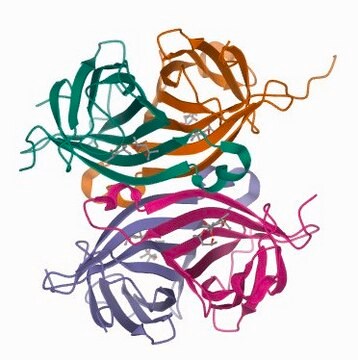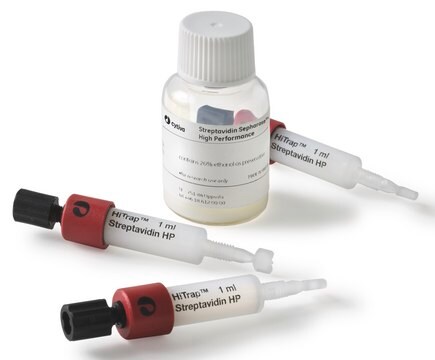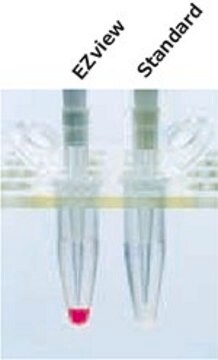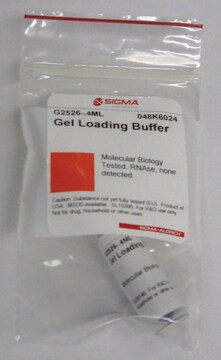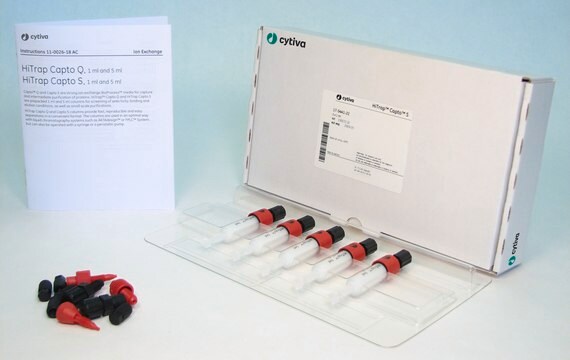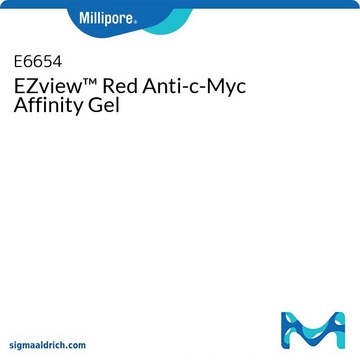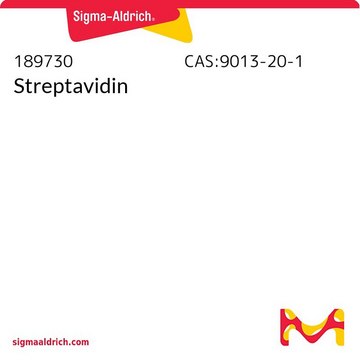Recommended Products
form
suspension
Quality Level
shelf life
1 yr
technique(s)
western blot: suitable
matrix
4% agarose
pH
7.2
capacity
~10 μg(biotin per ml of packed gel)
shipped in
wet ice
storage temp.
2-8°C
General description
The EZ View Red Streptavidin Affinity gel is composed of streptavidin, covalently attached to
cyanogen bromide-activated 4% agarose beads. It is designed to capture (pull-down) the biotinylated target molecules, such as proteins, peptides, antibodies, nucleic acids, lectins, receptors and ligands.
cyanogen bromide-activated 4% agarose beads. It is designed to capture (pull-down) the biotinylated target molecules, such as proteins, peptides, antibodies, nucleic acids, lectins, receptors and ligands.
Application
Sutitable for use with immunoprecipitation, western blotting,and enzyme assays.
When performing small-scale affinity capture, such as immunoprecipitation, the affinity matrix is difficult to see in the microcentrifuge tubes. Accidental aspiration of the resin leads to quantitative variability in results. The EZview™ Red Affinity Gels greatly reduce the risk of pellet loss. EZview™ resins perform as well as conventional non-colored affinity gels, but allow the user to easily differentiate pellet from supernatant. This correlates to more accurate data because less protein is lost.
Features and Benefits
- Increased visibility - Red color reduces risk of incidental aspiration
- Improved recovery of target protein by reduced accidental loss
- Higher reproducibility - More consistent yields
Physical form
1:1 (v/v) suspension in PBS containing 50% glycerol and 15 ppm Kathon
Legal Information
EZview is a trademark of Sigma-Aldrich Co. LLC
Storage Class Code
10 - Combustible liquids
Flash Point(F)
Not applicable
Flash Point(C)
Not applicable
Choose from one of the most recent versions:
Already Own This Product?
Find documentation for the products that you have recently purchased in the Document Library.
Customers Also Viewed
Alicia M Bostwick et al.
Biochemical and biophysical research communications, 528(3), 580-585 (2020-06-09)
Mammalian cells contain genetic information in two compartments, the nucleus and the mitochondria. Mitochondrial gene expression must be coordinated with nuclear gene expression to respond to cellular energetic needs. To gain insight into the coordination between the nucleus and mitochondria
Marion Mussbacher et al.
Scientific reports, 9(1), 15403-15403 (2019-10-30)
Murine 3T3-L1 adipocytes share many similarities with primary fat cells and represent a reliable in vitro model of adipogenesis. The aim of this study was to probe the effect of S-nitrosoglutathione (GSNO) on adipocyte differentiation. Adipogenesis was induced with a
Katarzyna M Zientara-Rytter et al.
Cells, 11(1) (2022-01-12)
Pex11, an abundant peroxisomal membrane protein (PMP), is required for division of peroxisomes and is robustly imported to peroxisomal membranes. We present a comprehensive analysis of how the Pichia pastoris Pex11 is recognized and chaperoned by Pex19, targeted to peroxisome
Ting-Yu Chang et al.
Biomedicine & pharmacotherapy = Biomedecine & pharmacotherapie, 138, 111485-111485 (2021-03-20)
Aberrant alteration of epigenetic information disturbs chromatin structure and gene function, thereby facilitating cancer development. Several drugs targeting histone deacetylases (HDACs), a group of epigenetic enzymes, have been approved for treating hematologic malignancies in the clinic. However, patients who suffer
Cideb controls sterol-regulated ER export of SREBP/SCAP by promoting cargo loading at ER exit sites.
Lu Su et al.
The EMBO journal, 38(8) (2019-03-13)
SREBPs are master regulators of lipid homeostasis and undergo sterol-regulated export from ER to Golgi apparatus for processing and activation via COPII-coated vesicles. While COPII recognizes SREBP through its escort protein SCAP, factor(s) specifically promoting SREBP/SCAP loading to the COPII
Related Content
Pull-down assays, reagents, and protocols for investigating in vitro protein-protein interactions using affinity or GST pull-down, tandem affinity purification (TAP), and co-immunoprecipitation methods.
Our team of scientists has experience in all areas of research including Life Science, Material Science, Chemical Synthesis, Chromatography, Analytical and many others.
Contact Technical Service